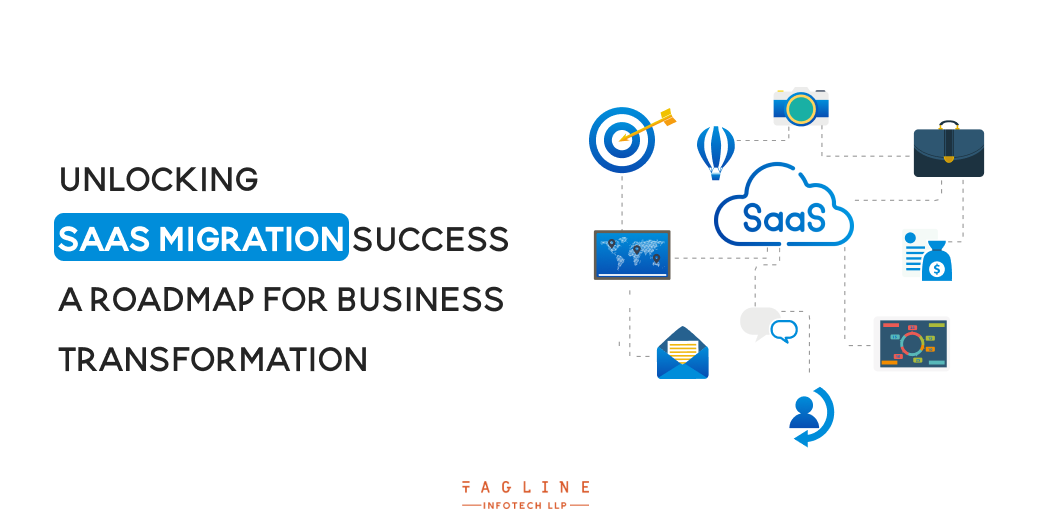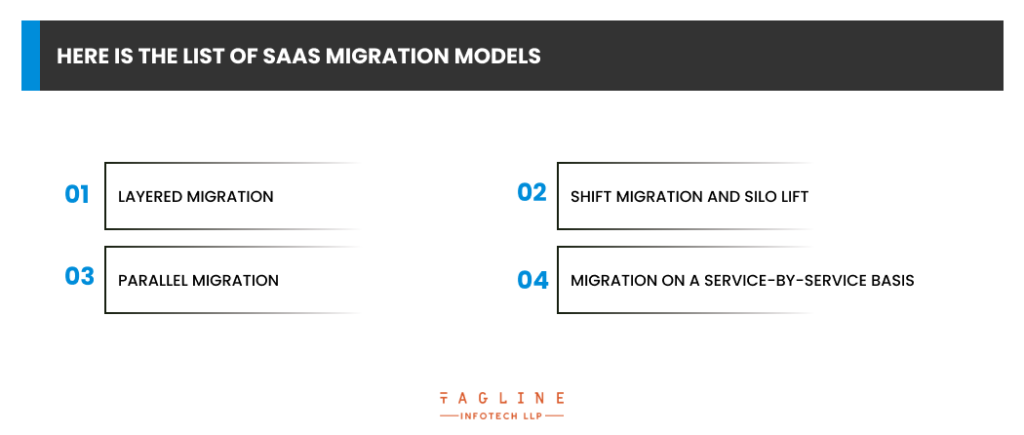A Guide on Data Visualization in ReactJS and...
May 15, 2024
Home >> SaaS Development >> Unlocking SaaS Migration Success: A Roadmap for Business Transformation

In the growing business environment, if you want to stay in the front line, then know it needs many organizations to endorse technical advancements.
Most of the transformations these years have grown with the prominence of many cloud-based solutions, and SaaS is in the leading position. Data migration is a complicated process and as a developer you need to create a detailed SaaS migration plan.
The shift offers many benefits, and organisations do not need to pay any upfront price. They are spared the complications of the on-prises software and access to the latest software is provided.
The SaaS migration has developed strategies to stay ahead in this digital revolution and endorse the full potential of cloud-based applications.
Nevertheless, to determine whether migrating to SaaS is the appropriate decision for your organization, it’s crucial to comprehend its scope and the proper execution process. Data migration is a complicated process and as a developer, you need to create a detailed SaaS migration plan.
The market trends are driving enterprises and increasing the SaaS migration to the cloud.
These trends shape economic conditions and stress upon the core competencies, mobility requirement, intensifying global competition and access to information in workplaces and pose limitations for conventional infrastructure.
Also, adding upon these factors, here is the list of statistics that can express that SaaS is the future, and this is the reason why organizations like the shift:
The above-listed statistics showcase the importance of the business landscape and why the shift is crucial for the business to maintain competitiveness and rise in the industry.
Transitioning to SaaS can significantly impact the success of your business. Some procedure allows the user to switch from one place directly to another, which will help you to move alongside the existing setups.
Here is the list of SaaS migration models:

Layered Migration
This model will allow you to move every layer related to the single-tenant system.
Irrestecive of the conventional data migration, this layer migration approach will move individual components or layers without obstructing the complete framework of a single-tenant style.
The model will rely on the key components’ automated provisioning and parallel migration.
While not commonly employed, this approach proves effective for businesses shifting from a single-tenant setup to a shared multi-tenant system.
Shift Migration and Silo Lift
The Shift Migration and Silo Lift model will transfer the entire system to the cloud.
This approach allows you to seamlessly migrate your whole technological infrastructure from an on-premise setup to a cloud-native environment without requiring substantial alterations.
If you are planning for data storage, tools and resources, the application will need a new domain is essential. It is the preferred option for organizations that can only partially rewrite their applications.
Parallel Migration
Keeping up with the new and old systems working together will be expensive and use up resources.
Also, the parallel migration model will solve the issues and create entirely new software with the help of different setups when the new software will be flexible and adaptable as per your requirements.
You can transition users to the new systems at a pace that suits your readiness and monitor their performance once the transition is complete.
The approach is best for businesses that do not take any risk, even though it can take a bit long.
Migration on a service-by-service basis
This model’s first task will allow you to select how to segment the single system into many services and will automate all services independently.
With the help of these services, this system can be transformed into SaaS.
Operating in a hybrid model that integrates your existing setup is crucial, ensuring the application’s continued operation while incorporating the new microservices model.
This model is excellent for businesses contemplating decomposing their system into microservices.
Check out these statistics which prove that SaaS migration is here to stay:
The expected data storage on the cloud is projected to exceed 100 zettabytes by 2025, driving substantial growth in SaaS Cloud Migration.
One of the successful SaaS companies based in the United States of America is Salesforce, which has a market value of over $200 bn.
In 2021, and as projected by Gartner, SaaS generated end-user spending that is anticipated to surpass $208 billion by 2023.
Also Read : What is the SaaS business model and how does it work?
Here is the list of benefits of SaaS Migration that you can look at:

Rapid Development
With the help of conventional on-premise systems, it needs time for setting up and software customization to meet the business requirements, which is quite tedious.
With the use of SaaS, the software is designed to keep industry best practices in mind, providing quick deployment.
The user needs a web browser to access the application, and it is accessible in a short period.
Cost-Efficiency
The SaaS allows the third-party providers to manage hosting, support, management and software creation, lowering the upfront cost.
The user can make payments regularly, especially for subscriptions, which is relatively cost-efficient for organizations to shift the expenses from infrastructure to operations.
Scalability
You can adapt your software usage to align with your requirements through SaaS cloud migration, ensuring long-term operational efficiency.
It guarantees operational efficiency as your business expands or encounters fluctuations in demand.
Reliability
While migrating to the SaaS business models, the service manager will eb managing everything, including maintenance, operations and business continuity.
It also ensures that the software is operational and reliable.
They will use service agreements to ensure the users are on the same page and keep the operations without causing any roadblocks.
IT innovation
There is no requirement for local server management and installation with the SaaS software.
Also, the user can access the applications via mobile apps or web browsers with IT resources focusing on many important aspects and innovations.
Pricing Models
SaaS migration different models offer usage-based pricing, which is flexible, fair and cost-effective.
Organizations will be paying for what they are using, can quickly adapt to the changing needs, and maintain the proper budget.
Resource Management
SaaS migration diminishes the requirement for extensive in-house software maintenance, updates, and support resources.
The resource management leads and streamlines to be quite efficient personnel allocation.
Client reach
It will help the SaaS business models offer services and products in a way that will help attract more clientele and grow the client base.
Avoiding investments in conventional software development and moving the offerings towards the cloud will help you create functional products, gaining many self-enabling clients.
Simplify your SaaS Migration Journey Today!
Partner with an experienced SaaS development company and make your move with confidence!

SaaS migration involves overcoming specific obstacles and knowing about potential challenges that can be taken care of. Here are some of the hurdles that you can be aware of:
Migration Price
For migrating towards the SaaS, the user can save a lot of money on maintenance and infrastructure, and additional expenses will also be allocated to the data migration and the adoption of new SaaS application procedures.
The employees also require training for adapting to the latest software. The issue can only be handled via budget planning for employee training and data transfer for managing the migration cost-effectively.
Security Obstructions
Enterprises should be aware of the security challenges of moving to the cloud, including implementing robust data security policies and safeguarding sensitive information.
Cloud services provide many measures, and the organizations are responsible for defining the assessments, security policies and configuration.
Clear communication is a must between cloud providers and businesses to clarify responsibilities and roles in maintaining a stable environment and following the SaaS best practices for security.
Interoperability concerns
Synchronising SaaS applications and the software can eb difficult as they need to work better together. It can obstruct the data flow and company operations.
To avoid this, conduct a compatibility test and consider many middleware solutions to ensure seamless integration via existing tools.
Dependable Connectivity
Mobile apps or web browsers need a stable and secure internet connection for accessing SaaS applications.
The SaaS is viable when you can access a high-speed and dependable internet connection.
If the internet you use is unreliable, you can address the issue of uninterrupted access in the cloud.
Integrations Customized for the Vendor
Many SaaS vendors do have specific integration requirements, which will make it quite challenging to integrate SaaS software solutions.
To address this issue, evaluate your selected SaaS applications’ compatibility with your current technology stack.
Seek out SaaS providers that provide open APIs and endorse widely recognized integration standards.
Compatibility Issues
Seamless data exchange between SaaS applications and current systems can prove intricate due to data structure and format variations.
Also, investing in many data integration platforms or tools will help transfer data between many software solutions. Always ensure that your data is organized and well-structured, simplifying the data exchange procedure.
The SaaS conversion strategy is needed as the conventional application strategies cannot supply the modern technology required by the company leader. SaaS migration strategy helps to implement robust security standards to keep the data safe.
To provide the business with an adaptable, user-friendly and intelligent application, they need the route to the digital transformation, and the executive is just left with the rigid suits of the right application.
Tagline is the best SaaS migration partner for these and additional compelling reasons. First, our expertise and experience in the SaaS migration space is unmatched.
Our experience includes successfully guiding companies toward cloud-based solutions while minimizing disruptions to operations and maximizing productivity.
Furthermore, Tagline strongly emphasizes cost-effectiveness, allowing you to maximize your IT budget and take advantage of SaaS benefits. Tagline is an application that runs on the cloud.
Tagline is the partner you can trust for a smooth and successful SaaS transition because of its customer-focused approach and unwavering commitment to offering top-notch support.
Using cloud power for SaaS migration is a way to transform business in the modern landscape. The SaaS migration also offers competitiveness, scalability, and cost-effectiveness.
Also, the partner will provide a reliable SaaS Development Company that can plan strategically and ensure the path matches the organization’s requirements.
It showcases the business future and ensures that the right approach can lead to long-term success, productivity and innovation.
Indeed, SaaS (Software as a Service) applications are developed using PaaS (Platform as a Service). With a SaaS application platform, you can create comprehensive solutions or prototypes for SaaS applications.

Digital Valley, 423, Apple Square, beside Lajamni Chowk, Mota Varachha, Surat, Gujarat 394101
+91 9913 808 2851133 Sampley Ln Leander, Texas, 78641
52 Godalming Avenue, wallington, London - SM6 8NW